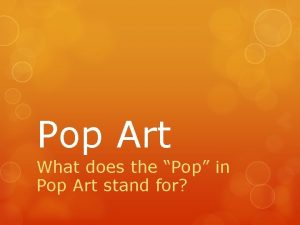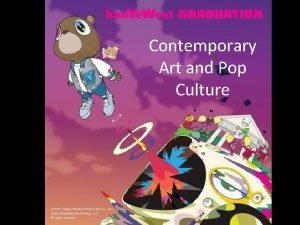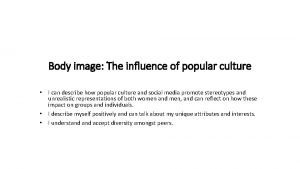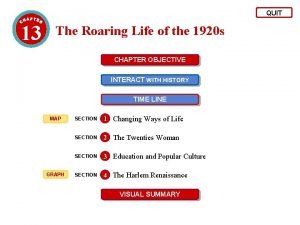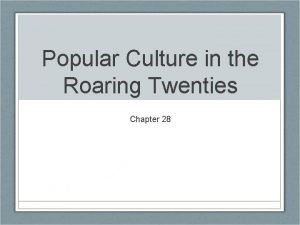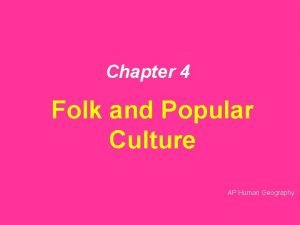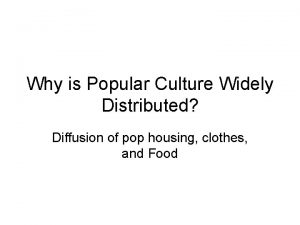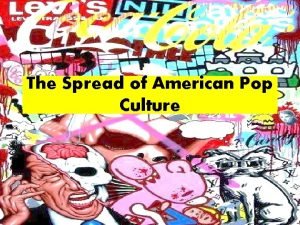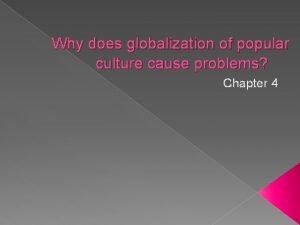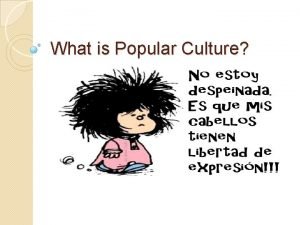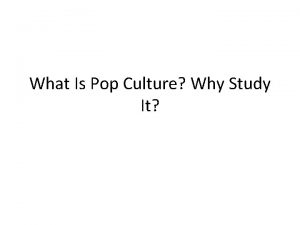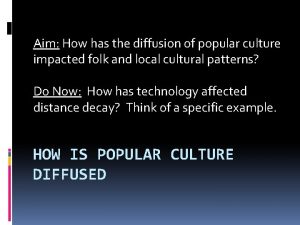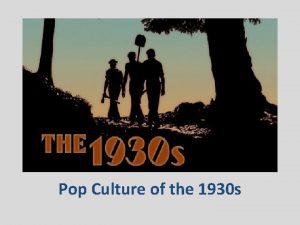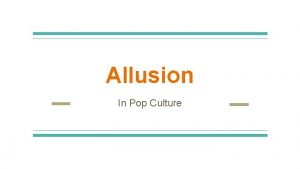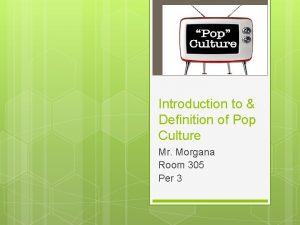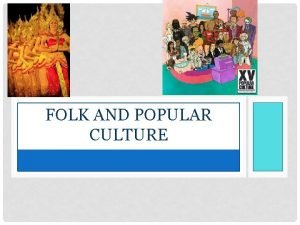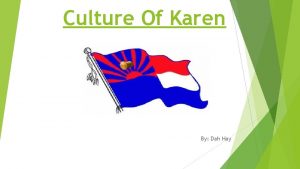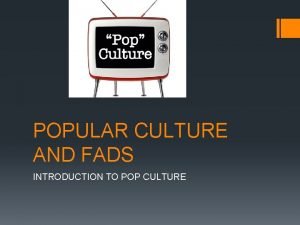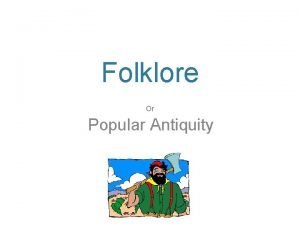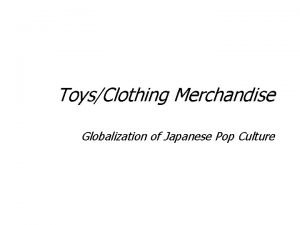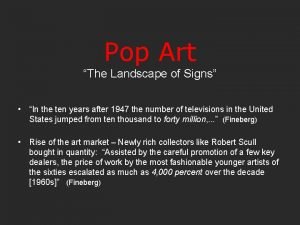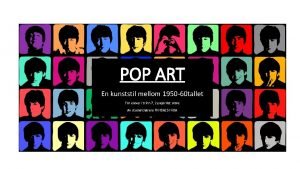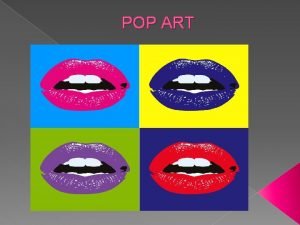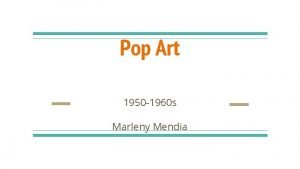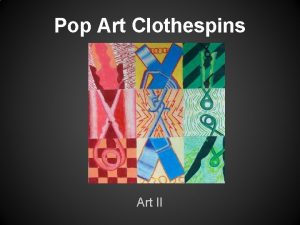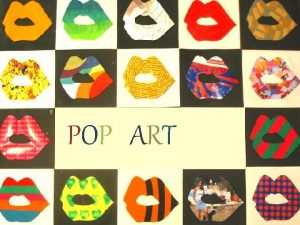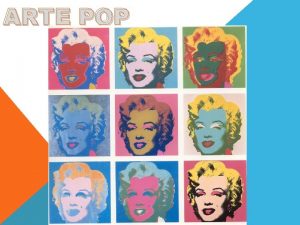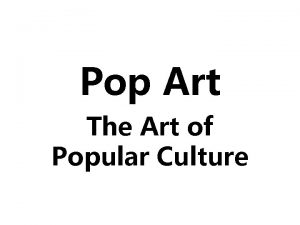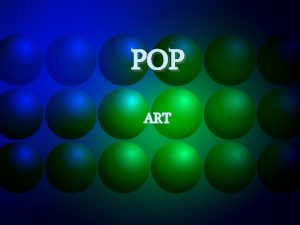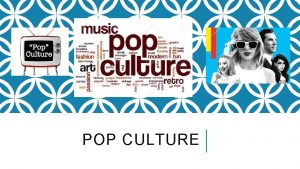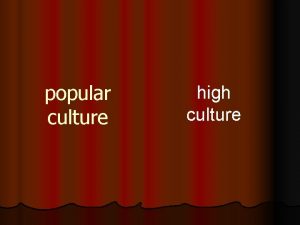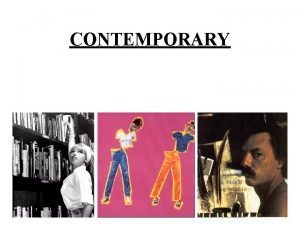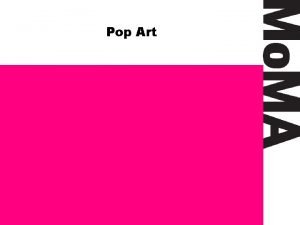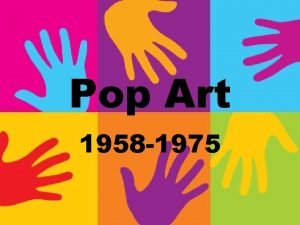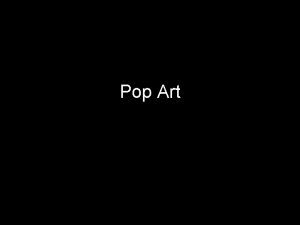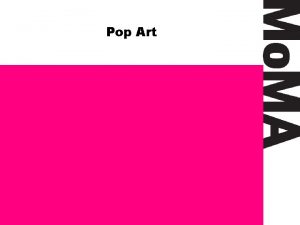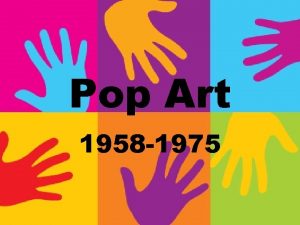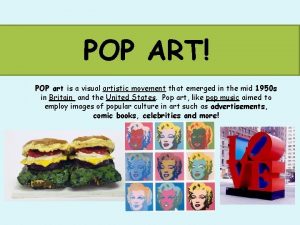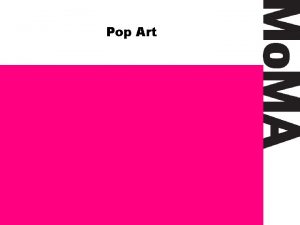Contemporary Art and Pop Culture Popular Culture Themes



































































- Slides: 67

Contemporary Art and Pop Culture

Popular Culture Themes: • The rise of the cult of celebrity • The perception-transforming power of mass media • Leveling of hierarchies (of taste, class, brands, art, etc. ) • The merge of art and business

Richard Hamilton, Just What Is It That Makes Today’s Homes So Different, So Appealing? 1956

“What’s great about this country is America started the tradition where the richest consumers buy essentially the same thing as the poorest. You can be watching TV and see Coca Cola and you can know that the president drinks Coke, Liz Taylor drinks Coke, and just think, you can drink Coke too. A Coke is a Coke, and no amount of money can get you a better Coke than the one the bum on the corner is drinking. All Cokes are the same, and all Cokes are good. ” Warhol, Coca-Cola, 1962

Andy Warhol’s installation at the Ferus Gallery, Los Angeles, 1962

Warhol, 32 Cans of Campbell’s Soup, 1962 Irving Blum (owner of the Ferus Gallery) bought the whole series for $3000 in 1962, then sold them to MOMA in 1996 for around $15 million (5, 000 times what he originally paid!!)

Warhol, 100 Campbell’s Soup Cans, 1962

Warhol, Detail of Campbel’s soup cans

Warhol, 100 Brillo Boxes, 1960

Warhol, Brillo Boxes, 1964 “Why is something that looks exactly like a Brillo Box a work of art, but a Brillo box is not? ”

Warhol, Gold Marilyn, 1962

Warhol, Marilyn, 1962

Warhol, Marilyn Monroe’s Lips, 1962

Warhol, National Velvet, 1963

Warhol, Triple Elvis, 1962

Warhol, Mona Lisa, 1963

Warhol, Red Race Riot, 1963

Warhol, Saturday Disaster, 1964

What connects products, celebrities, and disasters (Warhol’s subjects)? Why do you think he focused on these subjects? What themes in common can you identify?

Warhol was often critiqued for his “vulgarity”—what do you think? Is Warhol’s art vulgar, or is it a mirror of a vulgar culture?

Andy Warhol, 200 One Dollar Bills, 1962 (sold for $43, 762, 500 in 2009)

What is the proper role for art in society? What should art do? What should art be concerned with? What should art look like?

Warhol’s cover for the Velvet Underground, 1967

Warhol’s design for the Rolling Stones album Sticky Fingers, with actual zipper, 1971

Roy Lichtenstein, Image Duplicator, 1963


Lichtenstein, We Rose Up Slowly, 1964



Roy Lichtenstein, Drowning Girl, 1963

Lichtenstein, I Know How You Must Feel, Brad, 1963

Lichtenstein, Femme Au Chapeau, 1962

Lichtenstein, Little Big Painting, 1965


The Neo-Dadaists (Johns, Rauschenberg, Oldenburg) and the Pop artists (Warhol, Lichtenstein) all bring back subject matter to art, after the Abstract Expressionist rejection of subjects. How would you characterize the differences between Neo Dada and Pop use of and portrayal of subject matter (what kinds of subjects does each group use, and how are the subjects presented or represented)?

Barbara Kruger, Untitled (We don’t need another hero), 1985 • Postmodern works often use ambiguous language: who is “we”? Who is speaking? • Questions traditional roles and values


Barbara Kruger, Untitled (You Rule By Pathetic Display), 1985

Jenny Holzer, Truism Series, 1982 • Strategies of mass media and advertising • Aphorisms/slogans/cli chés: different meanings of each type? • Often contradictory • Who is speaking? Can they be trusted?

Jenny Holzer, Truism Series, 1982 Full list of Truisms

Ashley Bickerton, Tormented Self. Portrait, 1986 -87 "What exactly constitutes our notion of individual identity? We wake up in the morning and select our individuality from a finite catalogue of readymade possibilities. "

Jeff Koons, Art Magazine Ads (Artforum), 1988 -89

Jeff Koons, Art Magazine Ads (Art in America), 198889

Jeff Koons, Made In Heaven, 1989

Koons, Jeff and Ilona (Made in Heaven) 1989


Damien Hirst, The Physical Impossibility of Death in the Mind of Someone Living, 1991

Damien Hirst, The Physical Impossibility of Death in the Mind of Someone Living, 1991

Damien Hirst with shark

Damien Hirst, For the Love of God, 2007 Platinum cast of a skull set with 8, 601 diamonds, total carat weight of 1, 106. 81, and original teeth. Cost £ 14 million to produce, sales record is very sketchy, leading to questions about the nature and true amount of the sale, if there was one. Hirst claimed he sold it for £ 50 million cash, which is unsubstantiated.

David Byrne, “I don’t care about contemporary art anymore? ” • I go into a gallery now and—rightly or wrongly— immediately think, “inoffensive tchotchkes for billionaires and the museums they fund. ” • It’s sad—I used to be able to convince myself that contemporary art was some kind of forum for ideas and feelings about the world we live in. But hang on! It is! Those ideas and feelings are now about money and sucking up to those that have it and will part with a little bit of it. That is the world we live in!

David Byrne, “I don’t care about contemporary art anymore? ” • I can’t see the work or any ideas behind most of it anymore—if there even are any. The ideas might be there. The artists might be holding on to their integrity and be maintaining their distance from the dirty business of buying and selling… • Could painting—the sine qua non of arty baubles— become irrelevant and uncool not because of some reductionist spiritual aesthetic (as with Malevich’s work), but because it as a medium eventually loses all depth and human relevance due to economically inspired alienation?

Zbigniew Libera, LEGO Concentration Camp, 1996 “Nowadays, wars are no longer conducted just with the use of weapons, but also through consumption and culture. ”



Tom Sachs, Hello Kitty Nativity, 1994 (Barney’s Christmas Window)


Margaret Kilgallen, To Friend and Foe, 1999


Barry Mc. Gee (Twist), Untitled, 2009 (at SFMOMA)



Takashi Murakami, Tan Bo Puking, AKA Gero Tan, 2002 “I think that those who were able to enjoy consumer culture and the world of consumerism were the countries that were victorious during the war…I mean the U. S. and the British. Societies that lost the war, like Japan, envied the consumerism of the winners but they still wanted at least to be able to borrow what they envied. “

Takashi Murakami and Louis Vuitton collaboration

Takashi Murakami—Versailles, 2010


Takashi Murakami 2 Miss Ko , 1997 Murakami, Interview at Versailles
 What does the pop in pop art stand for?
What does the pop in pop art stand for? Folk culture and popular culture venn diagram
Folk culture and popular culture venn diagram Folk cultures are spread primarily by
Folk cultures are spread primarily by Homework due today
Homework due today Pop culture theme
Pop culture theme Art pop genre
Art pop genre The popular culture in the media
The popular culture in the media Folk and popular culture
Folk and popular culture Chapter 4 folk and popular culture
Chapter 4 folk and popular culture Chapter 13 section 3 education and popular culture
Chapter 13 section 3 education and popular culture Steamboat willie
Steamboat willie How do the origins of folk and popular culture differ
How do the origins of folk and popular culture differ Folk culture origins
Folk culture origins Daily life and popular culture in the 1950s
Daily life and popular culture in the 1950s How does folk culture diffuse
How does folk culture diffuse Why is access to folk and popular culture unequal
Why is access to folk and popular culture unequal Unit 3 ap human geography
Unit 3 ap human geography Pop culture body image
Pop culture body image 1920 popular culture
1920 popular culture Chapter 28 popular culture in the roaring twenties
Chapter 28 popular culture in the roaring twenties Deconstructing the popular
Deconstructing the popular Pop culture origin ap human geography
Pop culture origin ap human geography Popular culture collage
Popular culture collage Dse english electives
Dse english electives Chapter 19 section 3 popular culture
Chapter 19 section 3 popular culture Why is popular culture widely distributed
Why is popular culture widely distributed Universalization of popular culture
Universalization of popular culture Popular culture images
Popular culture images Popular culture ppt
Popular culture ppt Why does globalization of popular culture cause problems?
Why does globalization of popular culture cause problems? High culture
High culture Features of popular culture
Features of popular culture What is pop culture
What is pop culture What is popular culture
What is popular culture Non material culture examples
Non material culture examples What is pop culture
What is pop culture What is popular culture
What is popular culture What is assimilation
What is assimilation Popular culture diffusion
Popular culture diffusion 1930 pop culture
1930 pop culture Pop culture activities
Pop culture activities Definition of pop culture
Definition of pop culture Whats the definition of allusion
Whats the definition of allusion Pop vs folk culture
Pop vs folk culture Dramatic irony examples
Dramatic irony examples Pop culture tattoos
Pop culture tattoos Pop culture artwork
Pop culture artwork Pop culture definition
Pop culture definition Culture
Culture Karen pop culture definition
Karen pop culture definition Budaya di media siber
Budaya di media siber Pop culture adalah
Pop culture adalah Allusions to lord of the flies in pop culture
Allusions to lord of the flies in pop culture Fairies in pop culture
Fairies in pop culture Japanese pop culture trends
Japanese pop culture trends Workshop pop art
Workshop pop art Guerra fredda schema
Guerra fredda schema Pop art illustrator
Pop art illustrator Back seat dodge 38
Back seat dodge 38 Exhibition
Exhibition Pop art sculpture
Pop art sculpture Definisi pop art
Definisi pop art Andy warhol kunststil
Andy warhol kunststil Expresionismo abstracto caracteristicas
Expresionismo abstracto caracteristicas Pop art 1950 60
Pop art 1950 60 Pop art 1950-1960
Pop art 1950-1960 Dr stubbs
Dr stubbs Kunst
Kunst
